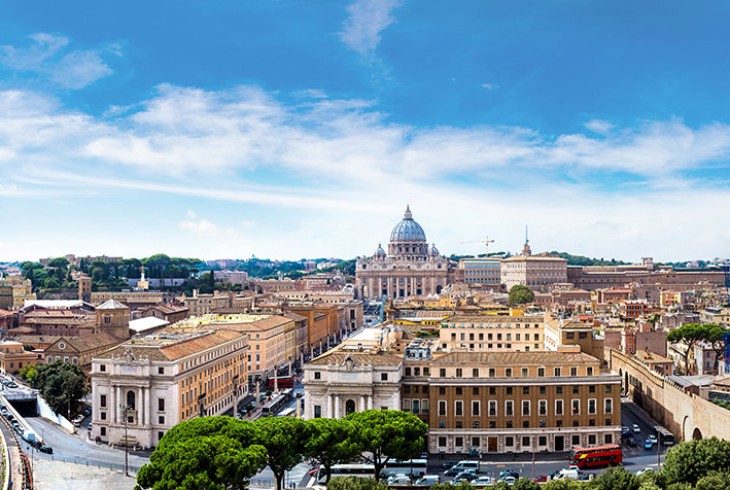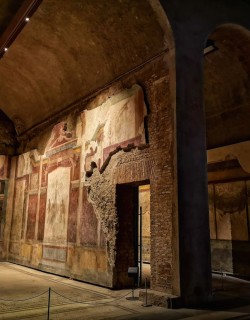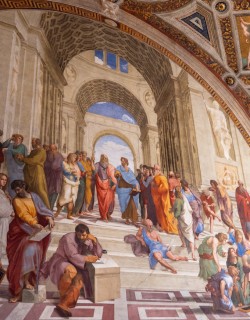1. Domitian’s Imperial Ramp
Walk the path of an emperor while you trace the steps of history in this breathtaking underground passageway. It enormous walls were designed to provide the ultimate protection and seclusion, allowing the Emperor to pass unseen from his luxurious palace into the forum. The walkway was newly restored in 2015 and four of its 7 ramps remarkably still exist today. Perhaps the most striking example of the meticulous restoration is the entrance of the aula, which is adorned with vibrant frescoes of the tragic “40 martyrs”. The martyrs were Roman soldiers who converted to Christianity and were then forced to stand naked in a freezing lake overnight until they froze to death.
2. The Church of Santa Maria Antiqua
On the northwest slope of Palatine Hill sits the oldest Christian monument in the Roman Forum and a powerful symbol of resistance. This defiant church has been severely damaged on numerous occasions, even to the extent of being completely buried for 1000 years after a devastating earthquake in 847. Now, after a painstaking restoration that took three decades, this remarkable church is now finally open to the public. It contains a stunning collection of paintings as old as the 6th century, including some very rare Byzantine frescoes. The thoughtful and modern touches to this site are the 3D reconstructions and video installations that really re-create the life and beauty of this ancient treasure.
3. The Spring of Juturna
The importance of water can never be underestimated for the Ancient Romans; their ingenuity in harnessing this precious life source was something that was heavily revered and respected. Juturna, goddess of fountains, wells and springs, is the mythical creature that this beautiful shrine is dedicated to, loved so much by Jupiter that he turned her into a spring of eternal youth. The fountain is located at the Temple of Romulus and dates back to the middle of the second century BC. According to Roman legend, its waters quenched the thirsts of divine twins, Castor and Pollux after their victory at the battle of Lake Regillus, 495 BC. The water was thought to have healing properties and the Romans would flock to it in the hopes of healing themselves of illness. In 2015 the restored seven sculptures connected to the Lacus Iuturniae context (the Dioscuri twins Castor and Pollux with their horses, the altar, the well-curb and a statue of Apollo) came back on public display at the Temple of Romulus, before being housed in the near Antiquarium Forense.
4. The Temple of Romulus
Dedicated to the son of Emperor Maxentius who died very young in 309 AD, the temple was actually completed by Constantine. The most striking element of this structure is the beautiful emerald-coloured bronze door, which is nearly 2000 years old and remains in incredibly good condition. Allegedly its ancient lock mechanism still works and its preservation is due to the fact that it was turned into the entrance to the Church of Saints Cosma and Damiano and is still a working structure today. Constantine altered the ancient semicircular façade and established the religion of the Penati, the gods who protected home and family together with goddess Vesta. After complex restoration works performed until 2000 and later, the Temple of Romulus was reopened in 2015 to exhibit the sculptures coming from the Spring of Juturna area (see the point 3 above).
5. Vicus Jugarius
In an outdoor museum as remarkable as the Roman Forum, it is easy to forget that the very streets and passages are themselves historical sites. Running between Capitoline Hill and Basilica Julia, Vicus Jugarius was an ancient street leading into the Roman forum to the river. It was a vital part of the city for trade and signifies just one of numerous road systems the Romans were famous for. It is extremely old even by Ancient Roman standards, some argue that it is even older than Rome itself and was part of an original trade route leading to the river. It was reopened in 2014 after a 4-year restoration as part of the 2000-year anniversary death of Rome’s first emperor Augustus.
6. The Forum shining at night
As of April 2015, the already stunning Roman Forum now appears as a majestic and theatrical spectacle in the hours of night. Oscar winner Vittorio Storaro designed the lighting system that beautifully illuminates the area to the delight of tourists and locals. This ingenious incentive not only showcases the city’s treasures but also allows extended access the area.
Would you admire this incredible sight? Learn more about our Colosseum and Roman Forum Night Tour.



